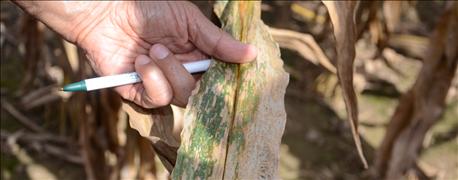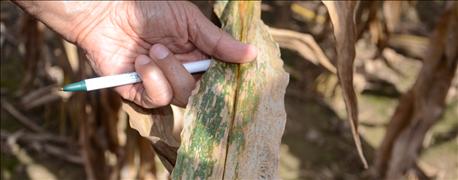
Agronomists who commented in late August and early September that diseases like southern rust came in late enough that they shouldn’t cause big yield losses were basing their statements on history and what should unfold. Mother Nature doesn’t read history books, and sometimes seems to get a charge out of upsetting the apple cart.

SOUTHERN RUST AND FRIENDS: Note the shiny red pustules on the upper right of the leaf. That’s southern rust. The leaf is also infested with gray leaf spot.
Large amounts of rain and extended periods of hot, humid weather near the end of the season in southern Illinois and Indiana turned the tables on both agronomists and the corn crop. “We wound up with a lot of very bad cornfields in the southwestern part of the state,” says Chris Perkins, manager of the CPS branch at Otwell, Ind., and a farmer himself. "Southern rust came in strong and just smacked corn yields in many fields in about 10 days.”
The results are low yields — under 100 bushels per acre, in some cases, he says. Add low prices and dirty, dusty harvest conditions caused by diseases, and it’s been a difficult, frustrating fall for many people, Perkins says.
“They don’t want sympathy or anything else, but they just want farmers in other areas to know that not everyone is having a good year,” he adds. “One customer says his grandfather calls it the worst hit by diseases since southern corn leaf blight nearly 50 years ago.”
Widespread hit
The same conditions extend across most of southern Illinois, according to Mike Wilson, an agronomist with Wabash Valley Services Co. He’s based in Allendale.
“It became a bad situation,” he agrees. “The corn was dirty, and anyone out in the fields came out orange from the rust.”
However, Wilson isn’t ready to blame the entire yield collapse on southern rust. “There were other things going on this year,” he says. “The corn crop was already dinged up in several areas from a dry June, followed by lots of rain late. We believe it’s hard to separate out how much of the yield loss was due to southern rust and how much was due to other factors."
Kiersten Wise, a Purdue University Extension plant pathologist, suggests Wilson is on the right track. Southern rust comes in most years. It went all the way to northern Indiana this year, but definitely hit harder than usual in southern counties.
“There were many other things going on which didn’t favor the crop in southern counties before the rust came in,” she says. “And it did come in fairly late. Quite a bit of the crop was planted late due to a wet spring. Stalk quality didn’t seem to be up to par even before disease came in. Many fields had anthracnose or other stalk rots which contributed to the dramatic decline of the crop. It’s not realistic to lay all of the blame on southern rust.”
Worst cases
Perkins acknowledges that some of the worst-hit fields were those planted late because it was simply too wet to plant any sooner. Some of them also weren’t sprayed with fungicide. Sometimes it was an economic decision because the farmer had already poured a lot of money into the crop, and corn prices were tanking, he adds.
Wilson saw a similar trend. “Fungicide applications paid in our area this year by as much as 20 bushels per acre,” he says. “However, where southern rust was the worst, even fungicides didn’t prevent some yield loss. Even yields in fields where fungicides were applied didn’t meet expectations.”
About the Author(s)
You May Also Like




